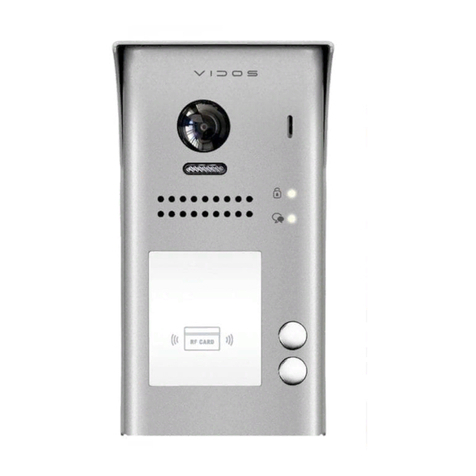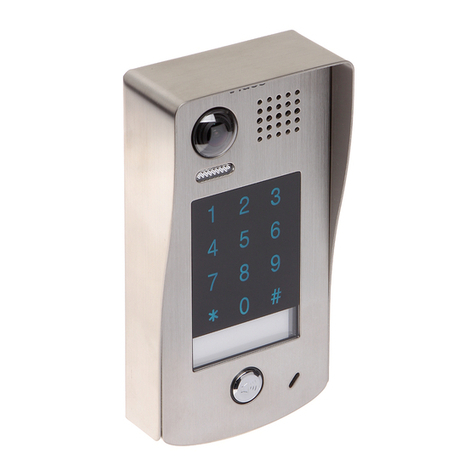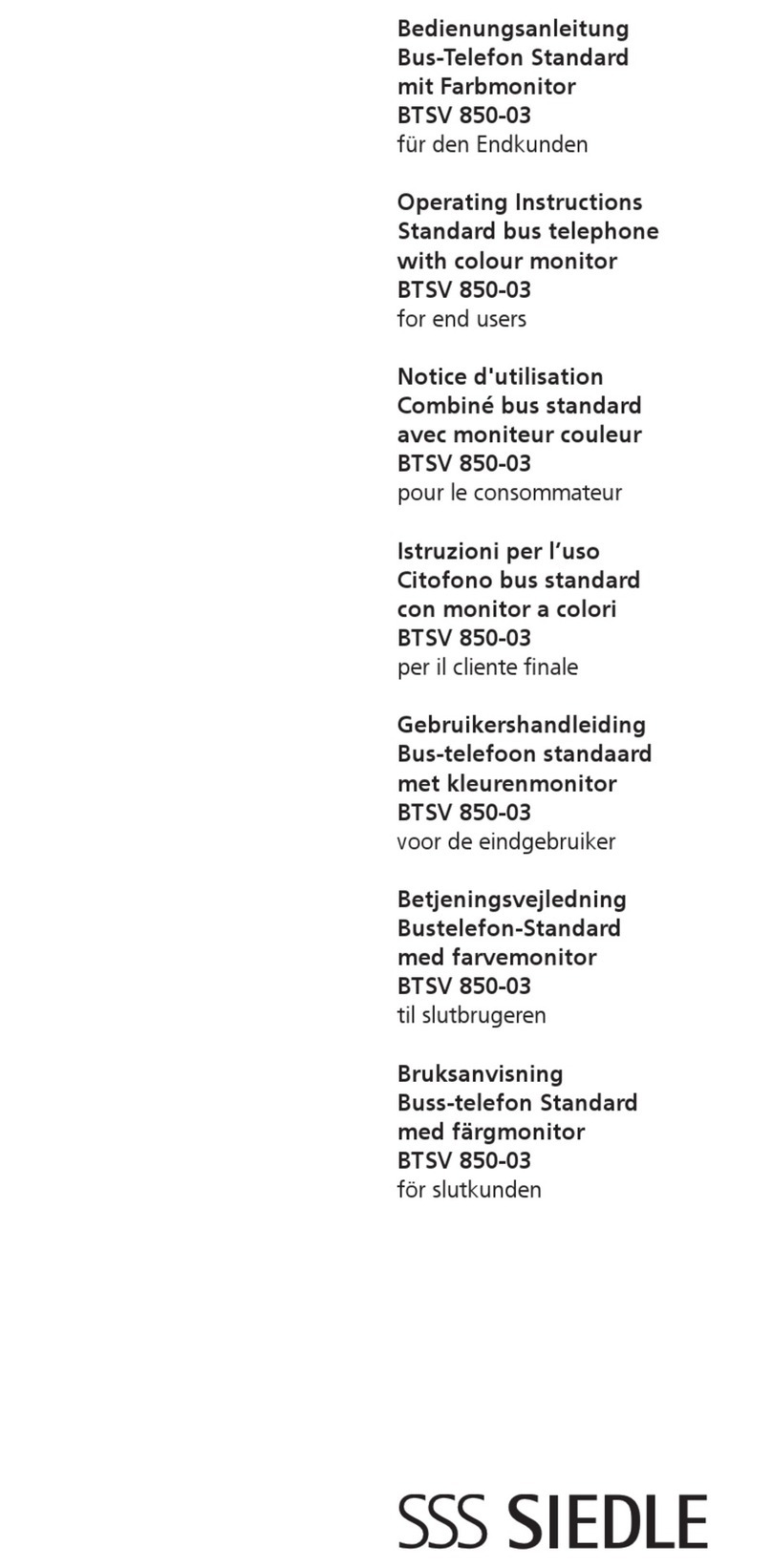
ELECTRIC LOCK CONNECTION
SPECIFICATION
1) Door Lock Controlled with Internal Power
1. The door lock is limited to 12Vdc, and holding current must be less
than 250mA when using internal power supply mode.
2. The Unlock Mode Parameter must be set to 0 (by default).
3. Jumper set to 1-2 position for power-off - t o - u n l ock safety
type(Normally closed mode); set to 2-3 position for power-on-to
-unlock type(Normally open mode ).
4. If different unlocking time is needed to be con fi gured, change the
unlock time on door station,detail information r e f e r to DUO system
technical guide .
2) Door Lock Controlled with External Power
1. The external power supply must be used according to the lock.
2. The jumper must be taken off before connecting.
3. Setup the Unlock Mode Parameter for different lock types
• Power-on-to-unlock type:Unlock Mode=0(by default)
• Power-off-to-unlock type:Unlock Mode=1
4. If different unlocking time is needed to be con fi gured, change the
unlock time on door station,more detail information refer to DT system
technical guide .
JP_LK
12V 300mA
Exit button
Jumper position in 2-3
+
-+12V
LK -
LK+
N.O.
EB-
EB+
1 2 3
Power-on-to-Unlock type:
Power-on-to-Unlock type:
12V 300mA
Jumper position in 1-2
+12V
LK -
LK+
N.O.
EB-
EB+
+
-
JP_LK
1 2 3
Exit button
Power-off-to-Unlock type:
Power-off-to-Unlock type:
+
+
-
-
+12V
LK - (GND)
LK+(COM)
N.O.
EB-
EB+
Take off the Jumper
JP_LK
Cut off the line
1 2 3
Exit button
+12V
LK - (GND)
LK+(COM)
N.O.
EB-
EB+
Take off the Jumper
+
+
-
-
JP_LK
Cut off the line
1 2 3
Exit button
• Power supply: DC26V (supplied by P26/40)
• Power Consumption: 1W in standby, 5W in working
• Unlock Power output: DC12V,250mA
• Unlock timing: 1~99s
• Working temperature: - 20ºC ~ +55ºC
• Dimension: 316(H)x133(W)x48(D)mm
INSTALLATION GUIDE
DIP SWITCHES SETTING
Totally 6 bits can be confi gured by dip-switch. Th e switches can be
modifi ed either before or after installation, but restarting th e power is
needed whenever the switches have been modifi ed.
Bit-1 and Bit 2 is for door station ID settings. When multi door stations
are installed in the system, these two bit must b e set correctly, the
fi rst door station set to 00, the second one set to 01, the third one set
to 10, the fourth one set to 11. If only one door station is installed, set
to 00.
Bit-3 is for single or double row button door st a t ion selection. If the
door station is a double row button, such as S1508A, set this bit to
0. For single row button door station,set to 1.
Bit-4 is for button code selection. if use the d e f a ult codes for each
button of the door station, set to 0. If use the programmed codes, set
to 1.(the code for each button can be programmed by software, detail
information refer to DUO MULTI system technical guide)
Bit-5 is for unlocking time quick setting. 0 is the default setting,and the
default time is 1 second. If set to 1,the unlock time is 5 seconds(the
unlock time can be modifi ed by door station or software)
Bit-6 is for activating the key A and key B. Normally key A and key B
is not activated(about the functions of key A and key B,please refer to
DT system technical guide ),Just when it set to 1,the key A and key B
is activated.
ON(1)
=
OFF(0)
=
ON
ON
ON
1 2 3 4 5 6
-4-
CAMERA MODULE
Note: Key A and key B can not be seen on the panel,they are cryptic.
Normally,key A and key B are not activated. To activate the buttons,
just set the DIP6 to ON.
Attention: All settings will be canceled if the Restore Factory Setting
is activated. Include the modules setting,such a s ID module, Touch
Keypad module…etc. Even if the modules are not con n ected to the
Camera Module.
When in standby mode. Short out the Exit Button Port(EB+,EB-)
,
then continuously toggle the DIP6 switch for 4 tim e s with a warning
sound of BP+, and the three Indicators will blin k a t the same time,
that means the Restore Factory Setting is in progress; If the three
Indicators turn off with a warning sound of BP+,it means the Restore
Factory Setting is fi nished.
Please know that the DIP6 switch must be set to ON while the others
are set to OFF to carry on the following settings.
When the door station with Camera Module is in standby.
(1)Press Key A, the Unlock indicator turns on with the warning sound
of BP+, BP;
(2)Press Key A again to set the Unlocking Mode to Normally On or
Normally Closed Normally On: the Status indicator blinks for one
time with the warning sound of BP+; Normally Closed:the Status in-
dicator blinks for twice with the warning sound of BP+, BP).
If TFT Module is connected, the info will be displayed on screen.
When the door station with Camera Module is in standby.
(1)Press Key A, the Unlock indicator turns on with the warning sound
of BP+, BP;
(2)Press Key B and hold on to enter the Unlocking Time Delay Set-
ting, a warning sound of BP will be heard and the Status indicator
blinks one time per second.
The counting of Unlocking Time is the times that Status indicator
blinks(the units is second). For example,the Status indicator blinks
for four times,that means the unlocking time is 4 seconds.
When the door station with Camera Module is in standby.
(1)Press Key A and hold on for 3 seconds to enter the Warning Tune
Option Mode, the Status indicator turns on and the current tune is
playing;
(2)Press Key A again to play next tune;
(3)Press Key B to quit.
When the door station with Camera Module is in standby.
(1)Press Key B to enter Tune Volume Setting, the Talk indicator
turns on,at the same time, play the tune at current volume;
(2)Press Key A to increase/decrease the volume;
(3)Press B to exit.
If TFT Module is connected, the current Volume will be displayed on
screen.
(1)During conversation, press Key B and hold on f o r 3 seconds to
enter the Talk Volume Setting, The Talk indicator turns on with the
warning sound of BP+,BP;
(2)Press Key A to increase/decrease the volume.
(3)Press Key B to exit.
• Unlocking Mode Setting
• Unlocking Time Delay Setting
• Warning Tune Setting
• Tune Volume Setting
• Talk Volume Setting
Speaker
Camera lens
Night view LED
MIC
Invisible key A
Status indicator
Talk indicator
Unlock indicator
Invisible key B
MODULES
1. Parts and functions
2. Settings via touch button
3. Restore factory setting
-5-
































